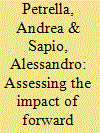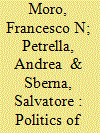|
|
|
Sort Order |
|
|
|
Items / Page
|
|
|
|
|
|
|
| Srl | Item |
| 1 |
ID:
111084


|
|
|
|
|
| Publication |
2012.
|
| Summary/Abstract |
How do policy actions affect the dynamics of deregulated electricity prices? We investigate this issue in the context of the Italian Power Exchange (IPEX), using data on the daily average day-ahead price (PUN) between April 2004 and December 2008.
Estimates of baseline time series models (SARMAX and SARMAX-EGARCH) and their forecasting performances suggest that the trend in natural gas prices, market power indicators, deterministic weekly patterns, perceived temperatures, persistence in conditional volatility, and the inverse leverage effect are essential features of the PUN dynamics. We then augment the best-performing models with dummies that account for changes in the market architecture, such as the introduction of contracts for differences (CfDs) to support renewables, trading of white certificates for energy efficiency, and the demand-side liberalization. The findings show that changes in the market architecture affected both the PUN level and its volatility. Specifically, wholesale electricity prices and volatility appear to have decreased upon the introduction of CfDs, only to be pushed upwards following the start of white certificates' trading and retail liberalization. Moreover, after controlling for reforms the inverse leverage effect vanishes, and the persistence in volatility is lower than in the baseline estimates.
|
|
|
|
|
|
|
|
|
|
|
|
|
|
|
|
| 2 |
ID:
144930


|
|
|
|
|
| Summary/Abstract |
Violence perpetrated by organized crime nowadays represents a major threat to state stability, both because it directly challenges political institutions, targeting officials and using terrorist techniques, and because severe inter-group conflict strongly affects human security. Though it is a distinctive feature of illegal markets and a constant strategy of Mafia-like groups, the occurrence of violence is localized in time and space. The article aims to explain temporal and spatial variation in Mafia killings focusing on its political determinants, as organized crime is deeply embedded in the political system. The analysis shows that there is a clear link between the structure of the political markets and the severity of violence. In particular, the fragmentation of the political market is negatively associated with the strategy of criminal groups to exploit violence. By contrast, single-party dominance and bipartisanship lead to an increase in homicides since these organizations have few opportunities to access the political arena. Outcomes are assessed through the analysis of monthly homicides reported by police forces in Italian provinces from 1983 to 2008.
|
|
|
|
|
|
|
|
|
|
|
|
|
|
|
|
|
|
|
|
|